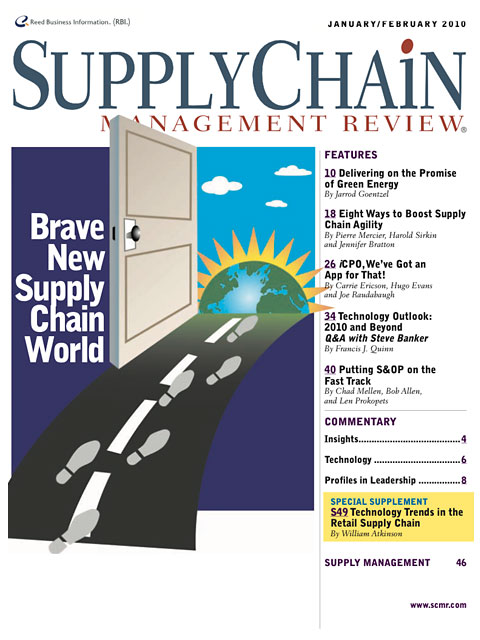Sorry, but your login has failed. Please recheck your login information and resubmit. If your subscription has expired, renew here.
January-February 2010
As the search for news forms of energy intensifies, supply chain professionals are presented with an unprecedented challenge and opportunity: To apply their managerial and analytical skills in delivering this energy to the end consumers. How effectively they respond may ultimately determine whether—and when—the promise of green energy finally gets fulfilled. Browse this issue archive.Need Help? Contact customer service 847-559-7581 More options
A.T. Cross, maker of A.T. Cross brand pens and other fine writing instruments and accessories, has been transforming itself and its product lines over the last few years. Between 2005 and 2007, the company completed a fundamental overhaul of its product line, bringing award-winning and innovative designs to market and breathing new life into a once old and tradition-bound product line.
As part of this transformation, A.T. Cross introduced 25 percent of its product mix as innovation, built a growing direct-to-consumer business, and opened new geographical regions through the U.S., Europe, and Asia. During this same period, it also moved its manufacturing and assembly operations from Lincoln, R.I., headquarters to a company-owned plant in China.
This aggressive transformation began paying off. The company experienced steady growth in a flat-to-declining market, and its new products and channel expansion promised an even more profitable future. By late 2007, however, inventory levels and product/channel complexity led to significant inventory imbalances. Thrust into the realities of managing a global supply chain, fast-moving, on-demand, consumer goods market, management realizes that the longer supply chain and historic planning practices brought with them a distinct set of challenges.
 |
This complete article is available to subscribers
only. Click on Log In Now at the top of this article for full access. Or, Start your PLUS+ subscription for instant access. |
SC
MR
Sorry, but your login has failed. Please recheck your login information and resubmit. If your subscription has expired, renew here.
January-February 2010
As the search for news forms of energy intensifies, supply chain professionals are presented with an unprecedented challenge and opportunity: To apply their managerial and analytical skills in delivering this energy… Browse this issue archive. Download a PDF file of the January-February 2010 issue.
 |
Download Article PDF |
A.T. Cross, maker of A.T. Cross brand pens and other fine writing instruments and accessories, has been transforming itself and its product lines over the last few years. Between 2005 and 2007, the company completed a fundamental overhaul of its product line, bringing award-winning and innovative designs to market and breathing new life into a once old and tradition-bound product line.
As part of this transformation, A.T. Cross introduced 25 percent of its product mix as innovation, built a growing direct-to-consumer business, and opened new geographical regions through the U.S., Europe, and Asia. During this same period, it also moved its manufacturing and assembly operations from Lincoln, R.I., headquarters to a company-owned plant in China.
This aggressive transformation began paying off. The company experienced steady growth in a flat-to-declining market, and its new products and channel expansion promised an even more profitable future. By late 2007, however, inventory levels and product/channel complexity led to significant inventory imbalances. Thrust into the realities of managing a global supply chain, fast-moving, on-demand, consumer goods market, management realizes that the longer supply chain and historic planning practices brought with them a distinct set of challenges.
 |
SUBSCRIBERS: Click here to download PDF of the full article. |
SC
MR

Latest Supply Chain News
- How CPG brands can deliver on supplier diversity promises
- How S&OP provides the answer to in-demand products
- AI, virtual reality is bringing experiential learning into the modern age
- Humanoid robots’ place in an intralogistics smart robot strategy
- Tips for CIOs to overcome technology talent acquisition troubles
- More News
Latest Podcast

 Explore
Explore
Latest Supply Chain News
- How CPG brands can deliver on supplier diversity promises
- How S&OP provides the answer to in-demand products
- AI, virtual reality is bringing experiential learning into the modern age
- Humanoid robots’ place in an intralogistics smart robot strategy
- Tips for CIOs to overcome technology talent acquisition troubles
- There is still work to do to achieve supply chain stability
- More latest news
Latest Resources

Subscribe

Supply Chain Management Review delivers the best industry content.

Editors’ Picks





